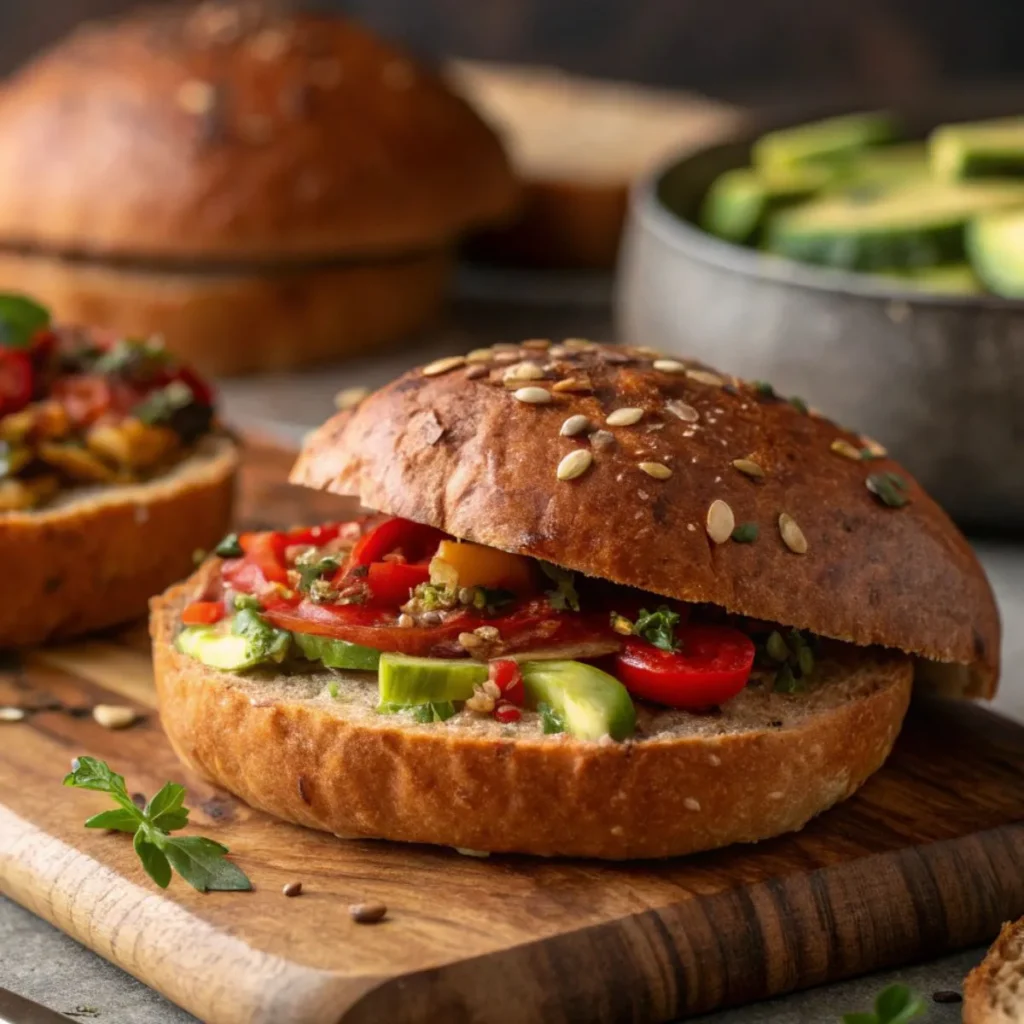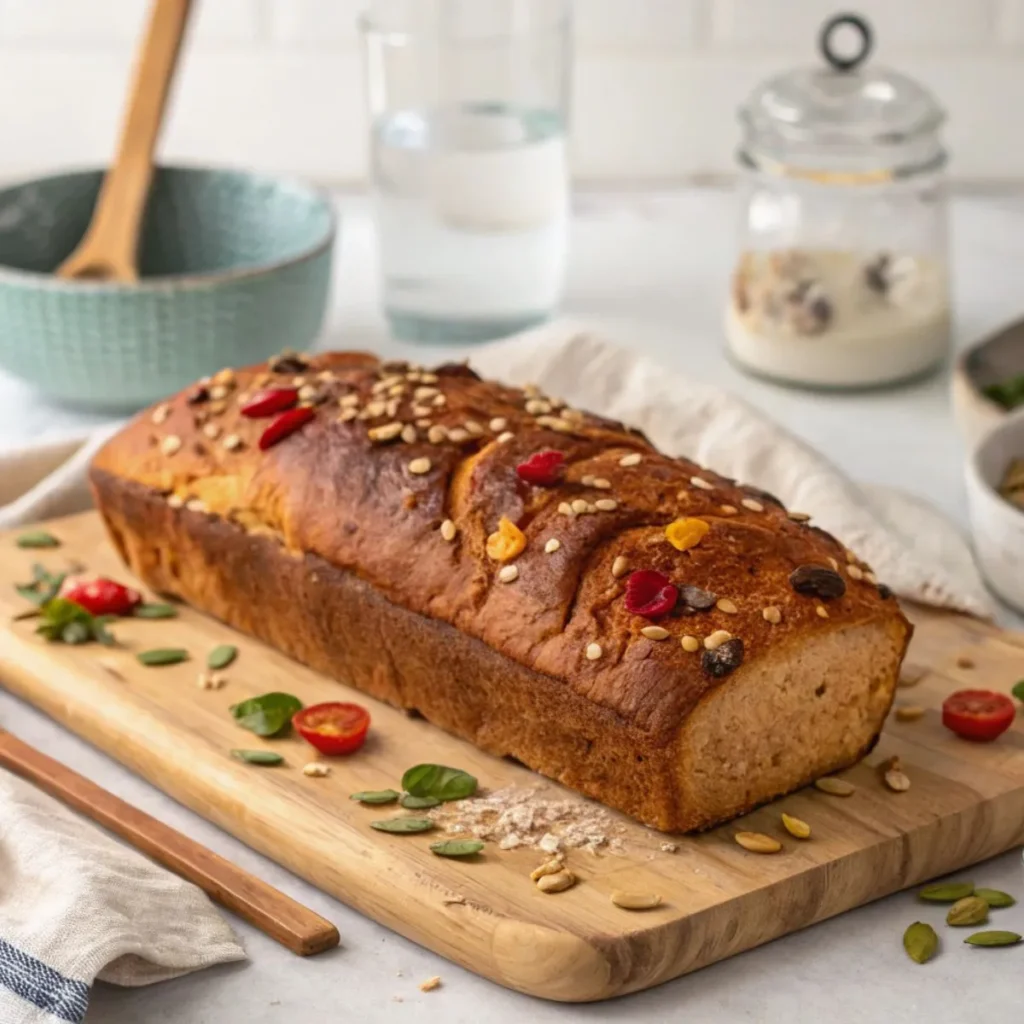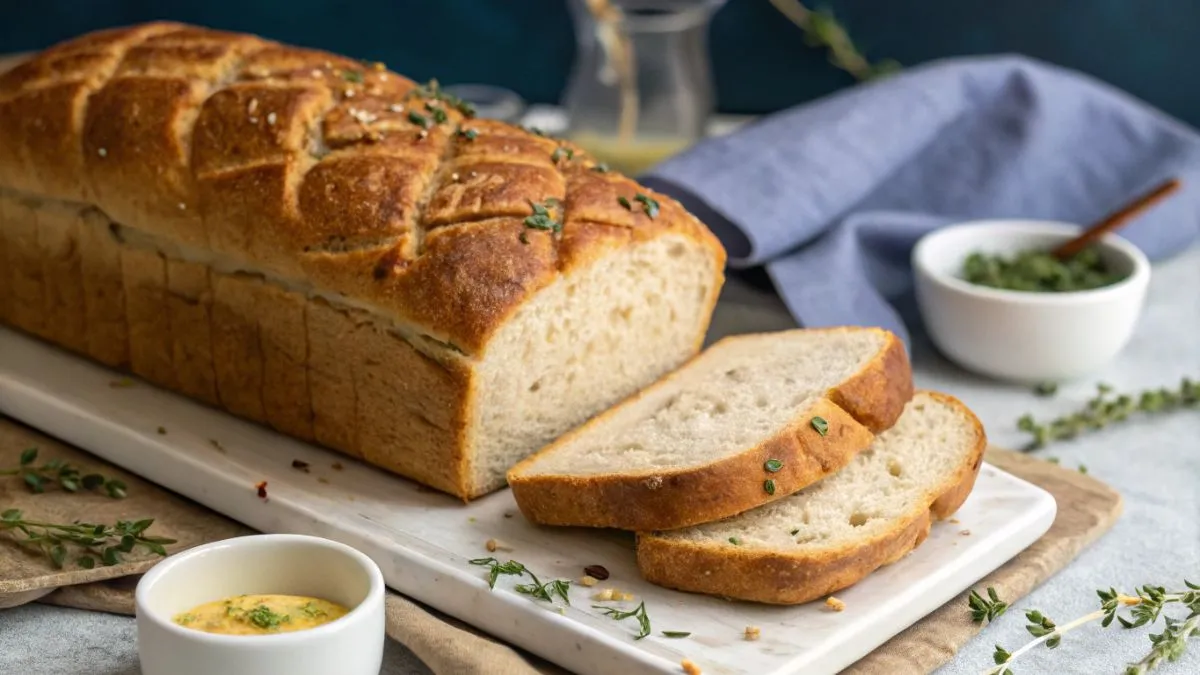Table of Contents
The Best Homemade Vegan Bread Recipe: Easy and Delicious
Introduction
Bread is a universal comfort food, but finding the perfect vegan version can feel like a challenge. Fortunately, making your own vegan bread at home is easier than you might think! By skipping animal products like eggs, butter, and milk, you can create a delicious, fluffy loaf that’s cruelty-free, healthier, and just as satisfying. Whether you’re new to baking or a seasoned pro, this guide will walk you through everything you need to know to craft the ultimate vegan bread.
This article will cover essential ingredients, a step-by-step recipe, and tips to make sure your bread comes out perfect every time. Plus, we’ll explore variations and answer common questions so you can bake with confidence.
Key Takeaways
- Simple Ingredients, Big Flavor: Vegan bread relies on basic pantry staples like flour, water, yeast, and plant-based fats for rich flavor and texture.
- Healthier Option: Without dairy or eggs, vegan bread is lower in cholesterol and often more nutrient-dense.
- Customizable Recipes: Easily adapt vegan bread recipes to include whole grains, seeds, or even sweet additions like raisins or cinnamon.
- Beginner-Friendly: Even if you’re new to baking, vegan bread is approachable and forgiving with the right techniques.
- Storage Tips: Learn how to store your homemade bread to keep it fresh longer, whether freezing or keeping it on the counter.
- Sustainable Choice: Making your own vegan bread reduces packaging waste and supports an eco-conscious lifestyle.
Why Choose Vegan Bread?
Vegan bread isn’t just a dietary choice—it’s a step toward a healthier, more ethical, and environmentally-friendly lifestyle. Here’s why making or choosing vegan bread is a great option for everyone, not just vegans:
1. Health Benefits
- Lower in Cholesterol: Traditional bread recipes often include eggs and butter, which are high in cholesterol. Vegan bread eliminates these ingredients, making it a heart-healthy choice.
- Rich in Nutrients: Many vegan bread recipes incorporate whole grains, seeds, and nuts, providing fiber, vitamins, and minerals essential for overall health.
- Allergy-Friendly: By excluding dairy and eggs, vegan bread is suitable for those with lactose intolerance or egg allergies.
2. Ethical and Cruelty-Free
Choosing vegan bread means avoiding animal-derived products, aligning with a commitment to reducing animal suffering and supporting ethical food production.
3. Environmentally Friendly
- Lower Carbon Footprint: Producing plant-based ingredients has a smaller environmental impact compared to animal farming.
- Reduced Waste: Homemade vegan bread avoids excessive packaging, promoting sustainability.
4. Versatility and Creativity
Vegan bread recipes are incredibly versatile. From fluffy white loaves to hearty whole-grain options, you can experiment with flavors, textures, and mix-ins like herbs, garlic, seeds, or dried fruits.
5. Delicious and Satisfying
With the right techniques and ingredients, vegan bread can be just as soft, crusty, and flavorful as its traditional counterparts. Many people are surprised by how rich and satisfying vegan bread tastes, often preferring it to store-bought options.
6. Easy to Make at Home
Baking vegan bread is simple, with no need for special ingredients or equipment. It’s a fun and rewarding process that fills your kitchen with the comforting aroma of freshly baked bread.
Essential Ingredients for Vegan Bread
Creating delicious vegan bread begins with understanding its key ingredients. While traditional bread recipes often include dairy or eggs, vegan bread relies on simple, plant-based alternatives that deliver the same amazing taste and texture. Here’s a breakdown of the essential components:
1. Flour
Flour is the backbone of any bread recipe. Common options include:
- All-Purpose Flour: A versatile choice for soft and fluffy bread.
- Bread Flour: Higher protein content creates more structure and chewiness.
- Whole Wheat Flour: Adds a hearty texture and nutty flavor, with extra fiber and nutrients.
- Gluten-Free Flour: For those avoiding gluten, a blend of gluten-free flours can be used, along with a binding agent like psyllium husk or xanthan gum.
2. Yeast
Yeast is the leavening ingredient responsible for making bread rise. Two common types are:
- Active Dry Yeast: Needs to be dissolved in warm water before using.
- Instant Yeast: Can be mixed directly into the dry ingredients for convenience.
3. Liquid
Liquids hydrate the dough and help it form a cohesive structure. Options include:
- Water: The most basic and neutral option.
- Plant-Based Milk: Almond, soy, oat, or coconut milk can add richness and a subtle flavor.
- Aquafaba: The liquid from canned chickpeas, used for added moisture and binding in some recipes.
4. Sweetener (Optional)
Sweeteners help feed the yeast and add subtle flavor to the bread. Choose vegan-friendly options like:
- Sugar
- Maple Syrup
- Agave Nectar
5. Fat (Optional)
Adding fat enhances softness and flavor. Popular vegan fats include:
- Olive Oil: A classic choice for Mediterranean-style bread.
- Coconut Oil: Adds a hint of sweetness and richness.
- Vegan Butter: Great for soft sandwich bread.
6. Salt
Salt balances the flavors in bread and strengthens the dough structure. Sea salt or kosher salt works best.
7. Optional Add-Ins
Make your vegan bread unique by adding flavorful or nutritious extras:
- Seeds: Chia, flax, sunflower, or sesame seeds for crunch and nutrients.
- Herbs and Spices: Rosemary, garlic, or cinnamon for aromatic loaves.
- Dried Fruits or Nuts: Raisins, cranberries, walnuts, or almonds for a sweet or nutty twist.
With just these simple ingredients, you can craft delicious vegan bread tailored to your tastes and dietary needs!

Step-by-Step Vegan Bread Recipe
Use this simple step-by-step guide to create soft, flavorful vegan bread that’s ideal for any occasion.
Ingredients
- 3 ½ cups (450g) all-purpose or bread flour
- 1 packet (2 ¼ tsp) active dry yeast
- 1 ½ tsp salt
- 1 tbsp sugar or maple syrup
- 1 ¼ cups (300ml) warm water (110°F/45°C)
- 2 tbsp olive oil or melted vegan butter
Instructions
Step 1: Activate the Yeast
- In a small bowl, mix together warm water and sugar. Stir until the sugar dissolves.
- Sprinkle the yeast into the water and let it rest for 5-10 minutes until it turns frothy. This indicates that the yeast is active.
Step 2: Mix the Dough
- In a large mixing bowl, stir together the flour and salt.
- Pour the frothy yeast mixture and olive oil into the dry ingredients.
- Stir with a spoon or use your hands until the dough forms a shaggy ball.
Step 3: Knead the Dough
- Transfer the dough to a lightly floured surface.
- Knead for 8-10 minutes until the dough is smooth, elastic, and slightly tacky but not sticky.
- If the dough feels too dry, incorporate water one teaspoon at a time. If the dough is too sticky, incorporate a bit more flour.
Step 4: First Rise
- Place the kneaded dough into a lightly oiled bowl, turning it to coat the surface with oil.
- Cover the bowl with a clean kitchen towel or plastic wrap to trap in the warmth.
- Let the dough rise in a warm place for 1-2 hours, or until it doubles in size.
Step 5: Shape the Dough
- Punch down the dough to release air bubbles.
- Transfer the dough to a floured surface and shape it into a loaf or your preferred form.
- Place the shaped dough into a greased loaf pan or on a lined baking sheet.
Step 6: Second Rise
- Cover the shaped dough and let it rise again for 30-45 minutes, or until it has puffed up.
- Preheat your oven to 375°F (190°C) as the dough is rising.
Step 7: Bake the Bread
- Place the bread in the preheated oven and bake for 25-30 minutes, or until the crust is golden brown and the loaf sounds hollow when tapped on the bottom.
- Optional: Brush the crust with olive oil or plant-based butter for extra shine and softness.
Step 8: Cool and Serve
- Take the bread out of the oven and let it cool in the pan for 5 minutes.
- Move the bread to a wire rack to cool completely before slicing.
- Enjoy your homemade vegan bread fresh, or serve with your favorite spreads or toppings!
Tips for Baking Perfect Vegan Bread
Making vegan bread can be a fun and rewarding experience, but a few key tips can ensure that your loaf turns out perfectly every time. Here’s how to master the art of baking vegan bread:
1. Use the Right Flour
Choosing the correct flour is essential for the texture and structure of your bread:
- Bread Flour: Higher protein content helps create a chewier, fluffier loaf.
- Whole Wheat Flour: If using whole wheat, mix it with all-purpose flour to avoid a dense loaf, as whole wheat absorbs more liquid.
- Gluten-Free Flour: For gluten-free bread, make sure to use a blend of gluten-free flours (like rice, potato, or almond) and add a binding agent (like xanthan gum) for better structure.
2. Don’t Overwork the Dough
When kneading, be gentle. Over-kneading can result in tough bread. Knead until the dough is smooth and elastic, and be sure to give it time to rise properly. If you knead too aggressively, the bread may lose its lightness.
3. Be Patient with Rising Times
Rising times are crucial to allow the dough to develop flavor and texture. Don’t rush the process:
- Let the dough rise in a warm, draft-free area, like near an oven or on a countertop with a towel over it.
- If you’re in a hurry, use a warm oven with a bowl of hot water inside to create a warm, humid environment.
- Allow both the first and second rises to occur fully, without cutting the process short.
4. Temperature Matters
Yeast is sensitive to temperature, so:
- Warm Water: Always use warm—not hot—water (about 110°F/45°C) to activate the yeast. Too hot, and you’ll kill the yeast; too cold, and it won’t activate properly.
- Oven Temperature: Preheat your oven before baking to ensure even cooking. A too-hot oven can lead to burnt crusts while the inside remains raw.
5. Use a Baking Stone or Steel
If you have one, use a baking stone or steel to bake your bread. These surfaces retain heat and promote even cooking, resulting in a crispier crust and evenly baked interior. If you don’t have one, a simple baking sheet works fine!
6. Steam for a Crispy Crust
For an extra-crispy crust, introduce steam into the oven during the first few minutes of baking. You can do this by placing a small pan of water on the bottom rack of the oven or by spritzing the dough with water right before placing it in the oven. This mimics the steam ovens used in professional bakeries.
7. Don’t Forget to Cool
Once your bread is baked, let it cool on a wire rack. Don’t slice it immediately, as the bread continues to set while cooling. Cutting into it too soon can lead to a gummy, doughy texture.
8. Experiment with Add-Ins
Make your bread even more delicious with seeds, herbs, or dried fruits. Add them during the kneading stage or sprinkle them on top before baking for extra flavor and texture.
- Seeds: Chia, flax, sunflower, and sesame add crunch and nutrition.
- Herbs: Rosemary, thyme, or garlic can give your loaf a savory twist.
- Dried Fruit: Raisins, cranberries, or apricots can bring a touch of sweetness to the bread.
9. Monitor Baking Time and Temperature
Since every oven behaves differently, it’s important to monitor your bread while it bakes. If it’s browning too quickly, you can cover the top loosely with foil to prevent burning while the inside finishes cooking.
- Test for Doneness: Tap the bottom of the loaf when it’s done. If it sounds hollow, it’s ready.
10. Practice Makes Perfect
Don’t be discouraged if your first loaf doesn’t come out exactly as you hoped. Baking is a skill, and with practice, you’ll be able to tweak your technique to get the perfect loaf every time.
Common Mistakes to Avoid When Making Vegan Bread
Here’s a helpful table outlining common mistakes to avoid when making vegan bread, along with tips on how to correct them:
| Mistake | Why It Happens | How to Avoid It |
| Using Cold Water to Activate Yeast | Yeast needs warm water (110°F/45°C) to activate properly. | Always use warm water (not hot) to activate the yeast. |
| Not Letting Dough Rise Enough | Skipping or shortening the rising time can result in dense bread. | Allow the dough to rise patiently until it has doubled in size. |
| Over-Kneading the Dough | Kneading the dough too much can result in a tough and dense texture. | Knead the dough gently until smooth and elastic, but not too much. |
| Under-Kneading the Dough | Insufficient kneading can lead to uneven texture and poor rise. | Knead for the right amount of time—8-10 minutes—to develop gluten. |
| Using the Wrong Type of Flour | Not all flours have the same properties, leading to poor texture. | Choose the right flour for the recipe, and use bread flour for a chewier loaf. |
| Incorrect Oven Temperature | An oven that’s too hot or too cool can result in undercooked or burnt bread. | Preheat the oven properly and use an oven thermometer if necessary. |
| Not Testing for Doneness | Without testing, you risk underbaking or overbaking the bread. | Give the bottom of the loaf a tap—it should produce a hollow sound when it’s fully baked. |
| Skipping the Second Rise | The second rise is crucial for light, airy bread. | Let the dough rise fully during both rises, including the second one. |
| Not Using Enough Salt | Salt enhances flavor and strengthens the dough’s structure. | Always add the right amount of salt (usually 1-2 tsp per loaf). |
| Cutting the Bread Too Soon | Cutting into hot bread can result in a gummy, doughy texture. | Allow the bread to cool completely before slicing. |
Avoiding these mistakes will help you bake better vegan bread every time! Let me know if you’d like more specific advice or further explanation on any of these tips.
How to Store Vegan Bread for Freshness
Storing your homemade vegan bread properly ensures it stays fresh longer, maintaining its flavor and texture. Here are the best ways to store your bread and keep it at its best:
1. Let It Cool Completely
Before storing, always allow your bread to cool completely on a wire rack. Storing bread while it’s still warm can lead to condensation, which can make it soggy and shorten its shelf life.
2. Room Temperature Storage
- For Short-Term Use: If you plan to eat the bread within a few days, store it at room temperature.
- Use a Bread Box: A bread box is an ideal container for keeping bread fresh. It allows for some airflow while protecting the loaf from drying out.
- Paper or Cloth Bag: If you don’t have a bread box, you can wrap the bread in a clean cloth or place it in a paper bag. This keeps the bread crusty while maintaining moisture. Avoid plastic bags, as they can cause the bread to become soggy or moldy more quickly.
3. Freezing for Long-Term Storage
If you have more bread than you can eat in a few days, freezing is the best way to preserve it:
- Slice Before Freezing: Slice the bread before freezing to make it easier to grab individual pieces when you need them.
- Wrap It Well: Wrap the entire loaf or individual slices tightly in plastic wrap, aluminum foil, or a freezer-safe bag.
- Label and Date: Label your bread with the date so you can track how long it’s been in the freezer. Bread can last for up to 3 months in the freezer.
- Thawing: To thaw, simply let the bread sit at room temperature for a few hours or toast individual slices straight from the freezer.
4. Avoid Refrigeration
While it may seem like a good idea to store bread in the fridge, it can actually make the bread go stale faster. Refrigeration speeds up the process of bread losing moisture, making it dry and hard.
5. Refreshing Stale Bread
If your bread becomes a little stale, don’t throw it out! Revive it by:
- Oven Refresh: Sprinkle a little water on the crust and place the bread in a preheated oven at 350°F (175°C) for about 10 minutes. This will help restore some of its softness and crispness.
- Toasting: Sliced, stale bread makes great toast, adding a new texture and flavor.
By following these storage methods, your vegan bread will stay fresh longer and maintain its delicious taste. Let me know if you’d like more tips or have any specific storage questions!
Vegan Bread Variations to Try
Garlic Herb Rolls: Add minced garlic and dried herbs like rosemary to the dough for savory, bite-sized rolls.
Cinnamon Raisin Bread: Swirl cinnamon and raisins into the dough for a sweet and spicy loaf.
Olive Bread: Incorporate chopped olives into your dough for a Mediterranean-inspired twist.
Seeded Loaf: Add sunflower, sesame, or chia seeds for a crunchy, nutritious texture.
Mini Ciabatta: Create smaller, airy loaves with an open crumb and crispy crust.
Banana Bread: Make a moist, naturally sweet loaf using mashed bananas.

FAQ
Here are answers to some of the most frequently asked questions about vegan bread baking:
1. Can I use any type of yeast for vegan bread?
Yes, you can use both active dry yeast and instant yeast in vegan bread recipes. The difference lies in how they are activated: active dry yeast needs to be dissolved in warm water, while instant yeast can be mixed directly with the dry ingredients. Both work well for vegan bread.
2. Can I substitute flour in vegan bread?
Yes, you can substitute flour, but it may affect the texture of the bread. For example, whole wheat flour will make the bread denser, while gluten-free flours require additional binding agents (like xanthan gum or psyllium husk). If substituting flours, it’s best to follow specific recipes designed for those flours to ensure the best results.
3. What is the best type of flour for vegan bread?
The best flour depends on the texture you want:
- All-purpose flour is great for light and fluffy bread.
- Bread flour offers a chewier texture due to its higher gluten content.
- Whole wheat flour adds more fiber and a nutty flavor but may need extra water. For gluten-free bread, look for a blend of gluten-free flours, such as rice, almond, and potato flour.
4. How do I make vegan bread rise without eggs or dairy?
Vegan bread relies on yeast for rising, which doesn’t require eggs or dairy. Yeast feeds on the sugars in the dough and creates carbon dioxide, causing the bread to rise. Proper rising times and temperature are key for the dough to expand.
5. Can I make vegan bread without oil?
Yes, you can make oil-free vegan bread by simply omitting the oil. Some recipes use applesauce or other moisture-rich ingredients like aquafaba (chickpea water) to replace the oil while keeping the bread soft. The texture might be a little different, but it will still be delicious.
6. How long does vegan bread last?
Vegan bread typically stays fresh for about 2-3 days at room temperature when stored properly in a bread box or wrapped in a cloth. For longer storage, freeze it. Sliced bread can last up to 3 months in the freezer.
7. Can I make vegan bread without yeast?
Yes! You can make no-yeast vegan bread using baking soda or baking powder as a leavening agent. These breads tend to be quicker to make but may not have the same chewy texture as yeast-based bread. Soda bread is a popular no-yeast option.
8. How do I get a crispy crust on my vegan bread?
To achieve a crispy crust, try these tips:
- Steam: Place a pan of water in the oven during the first few minutes of baking or spritz the dough with water before putting it in the oven. This helps the crust form.
- Higher baking temperature: Bake at a slightly higher temperature (around 400°F/200°C) for the first 10 minutes, then reduce the temperature to 375°F (190°C).
- Brush with oil: After baking, you can brush the top with olive oil or vegan butter for a softer, shiny crust.
Conclusion
Baking vegan bread is a rewarding and creative process that allows you to enjoy delicious, plant-based loaves tailored to your tastes and dietary preferences. Whether you’re making a simple white loaf, experimenting with seeds and herbs, or creating a hearty whole grain version, vegan bread offers endless possibilities.
With the right ingredients, techniques, and a little patience, you can craft loaves that are not only healthier but also full of flavor. Remember, the key to perfect vegan bread is paying attention to factors like yeast activation, dough rising time, and careful storage to maintain freshness. Don’t be afraid to experiment with different flavors, textures, and variations to find your favorite combination.
By following the tips, troubleshooting common mistakes, and trying out different recipes, you’ll soon become a pro at baking homemade vegan bread.


2 thoughts on “Vegan Bread Recipe”